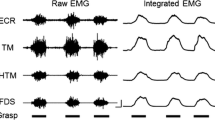Summary
The critical interval of the ulnar nerve was studied in two different ways in 15 normal subjects. Needle electrodes were used for application of stimuli giving the adventage to obtain a supramaximal excitation of the nerve by impulses of rather short duration and low intensity. Recording of nerve action potentials was done by needle electrodes as well, and amplitudes seen with this method were considerably higher than those recorded by surface electrodes.
After a single supramaximal stimulation of the nerve a second shock applied at the same site does not evoke a propagated nerve action potential until a certain interval (critical interval) of 0.55–0.70 msec has elapsed. This interval is markedly shortened to values between 0.35 and 0.55 msec if the first and the second stimulus are delivered to different points of the nerve, about 5 cm apart from each other.
Furthermore it was observed that at high stimulus intensities the critical interval is not altered by varying the duration of the stimulating impulses between 0.05 and 1.0 msec.
A possible explanation for these results is discussed.
Similar content being viewed by others
Literatur
Adrian, E.D.: The recovery process of excitable tissue. J. Physiol. (Lond.) 55, 193 (1921).
E. D. Adrian, and K. Lucas: On summation of propagated disturbances in nerve and muscle. J. Physiol. (Lond.) 44, 68 (1912).
Blair, E. A., and J. Erlanger: A comparison of the characteristics of axons through their individual electric responses. Amer. J. Physiol. 106, 524 (1933).
Brown, J. E.: M. S. Thesis Massasuchetts Institute of Technology 1960 (ref. by Gilliatt and Willison 1963).
Carpendale, M. T. F.: Conduction time in the terminal portion of the motor fibers of the ulnar, median and peroneal nerves in healthy subjects and in patients with neuropathy. M. S. Thesis (Phys. Med.), University of Minnesota (1956).
Dawson, G. D., and J. W. Scott: The recording of nerve action potentials through skin in man. J. Neurol. Neurosurg. Psychiat. 12, 259 (1949).
Eichler, W.: Über die Ableitung der Aktionspotentiale vom menschlichen Nerven in situ. Z. Biol. 98, 182 (1937).
Gasser, H. S., and J. Erlanger: The nature of conduction of an impulse in the relatively refractory period. Amer. J. Physiol. 73, 613 (1925).
Gilliatt, R. W., and R. G. Willison: The refractory and supernormal periods of the human median nerve. J. Neurol. Neurosurg. Psychiat. 26, 136 (1963).
Henriksen, J. D.: Conduction velocity of motor nerves in normal subjects and in patients with neuromuscular disorders. Thesis, Graduate School, University of Minnesota 1956.
Hopf, H. C.: Untersuchungen über die Unterschiede in der Leitgeschwindigkeit motorischer Nervenfasern beim Menschen. Dtsch. Z. Nervenheilk. 183, 579 (1962).
H. C. Hopf Das Elektromyogramm bei Nervenreizung. Fortschr. Neurol. Psychiat. 31, 585 (1963a).
H. C. Hopf Electromyographic study on so-called Mononeuritis. Arch. Neurol. (Chic.) 9, 307–312 (1963b).
—H. C. Hopf H.-J. Hufschmidt: Gibt es eine Doppelinnervation im menschlichen Muskel? Pflügers Arch. ges. Physiol. 275, 152 (1962).
Hunt, C. C.: Relation of function to diameter in afferent fibers of muscle nerves. J. gen. Physiol. 38, 117 (1954).
Kiraly, J. K., and K. Krnjevic: Some retrograde changes in function of nerves after peripheral section. Quart. J. exp. Physiol. 44, 244 (1959).
Krnjevic, K., R. R. Kilpatrick, and P. G. Aungle: A study of some aspects of nervous and muscular activity during experimental human salt deficiency. Quart. J. exp. Physiol. 40, 201 (1955).
Kuffler, S. W.: Physiology of neuro-muscular junctions; electrical aspects. Fed. Proc. 7, 437 (1948).
Pinelli, P., G. Lanzi, F. Savoldi e F. Zerbi: Questioni attuali sulla misura della velocita di conduzione delle fibre nervose motorie nell' uomo. Riv. Pat. nerv. ment. 82, 377 (1961).
Tasaki, J.: Conduction of nerve impulse. In: Handbook of Physiology S1: Neurophysiology, Vol. 1, 75ff. Williams & Wilkins Co.: Baltimore (1959).
Tasaki, J., und T. Takeuchi: Weitere Studien über den Aktionsstrom der markhaltigen Nervenfaser und die elektrosaltatorische Übertragung des Nervenimpulses. Pflügers Arch. ges. Physiol. 245, 764 (1942).
Author information
Authors and Affiliations
Additional information
Mit 2 Textabbildungen
Rights and permissions
About this article
Cite this article
Hopf, H.C. Das kritische Intervall peripherer Nerven bei Reizung am gleichen und an verschiedenen Orten. Pflügers Archiv 279, 67–72 (1964). https://doi.org/10.1007/BF00363321
Received:
Issue Date:
DOI: https://doi.org/10.1007/BF00363321




